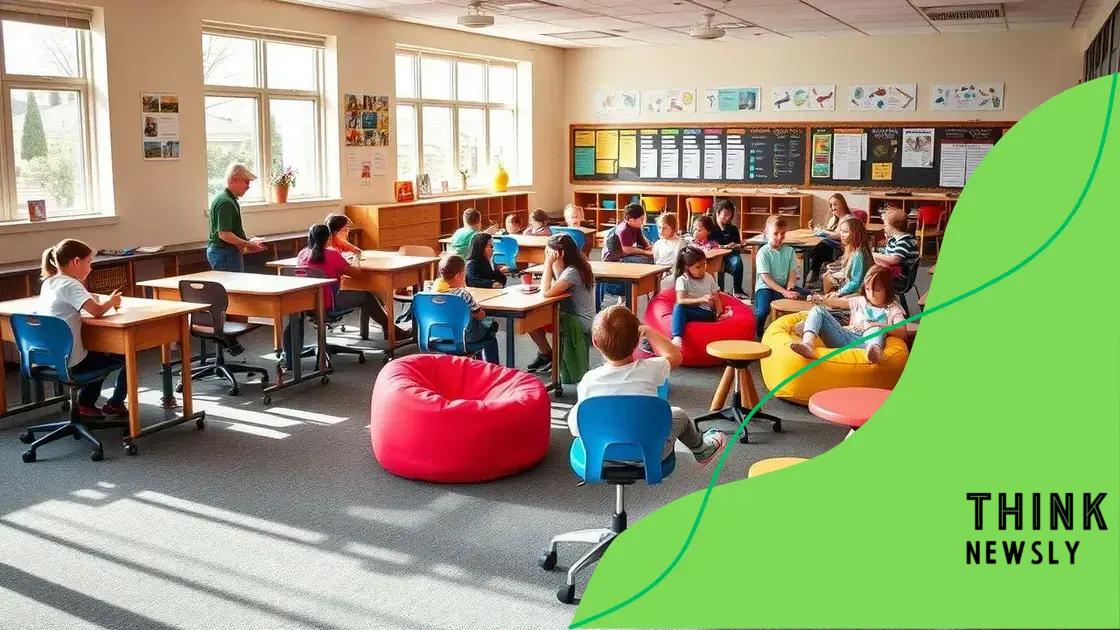Class chairs upgraded: transform your workspace today

Anúncios
Classroom furniture design trends focus on flexible seating, integrated technology, and eco-friendly materials to enhance learning environments and promote student engagement.
Class chairs upgraded can significantly enhance your learning environment. Have you ever considered how much comfort impacts focus and productivity? Let’s dive into the world of ergonomic seating options.
Anúncios
Benefits of upgraded classroom chairs
Upgrading classroom chairs can lead to significant improvements in both comfort and performance in learning environments. When students are more comfortable, they can focus better and engage more effectively with their lessons.
Enhanced Comfort
An important benefit of upgraded chairs is improved comfort. Ergonomically designed chairs support better posture, which can reduce fatigue during long classes. Students will find it easier to concentrate on their work without distractions from discomfort.
Increased Engagement
Comfortable seating encourages students to participate more. When they are not adjusting constantly to find a comfortable position, they can focus their attention on learning. This results in higher classroom involvement and a more dynamic learning experience.
Anúncios
Health Benefits
Investing in upgraded classroom chairs also contributes to students’ health. Proper seating can help prevent issues such as back pain and poor circulation. Listed below are some health benefits:
- Reduced risk of back strain
- Better circulation
- Improved posture
Long-Term Value
While the initial investment might seem high, upgraded chairs can save money in the long run. Durable, ergonomic designs reduce the need for frequent replacements, making them a cost-effective choice for schools.
In conclusion, upgraded classroom chairs not only enhance comfort but also boost student engagement and contribute to overall health in the learning environment. Schools that prioritize these upgrades will likely see positive changes in both student performance and satisfaction.
How to choose the right chair for comfort
Choosing the right chair for comfort can greatly affect how well students learn and engage in the classroom. When you have the right chair, it helps maintain focus and reduces distractions caused by discomfort.
Consider Ergonomics
One of the first things to look at is ergonomics. An ergonomic chair is designed to support the body’s natural posture. It helps minimize strain on the back and neck.
Adjustability Matters
Another key factor is adjustability. A chair that can be adjusted for height and armrests allows every student to find their ideal position. This promotes better posture during class.
Additionally, pay attention to materials. A chair with breathable fabric will keep students cool, especially during longer sessions. Also, consider cushioning—chairs that are too hard or too soft can be equally problematic. Here are some features to evaluate:
- Height adjustment options
- Support for the lower back
- Cushioning for comfort
Test Before You Buy
If possible, let students test chairs before making a purchase. Comfort is highly subjective, and what works for one may not work for another. Encourage them to sit for a few minutes to gauge comfort levels.
When evaluating chairs, visualize how they will fit into your classroom setup. Ensure they work with desks and allow enough space for movement. A good fit will enhance the overall learning environment and support more productive classes.
Styles of classroom chairs for every need

Classroom chairs come in a variety of styles to meet different needs. Selecting the right style can improve not just comfort, but also engagement in learning activities.
Standard Classroom Chairs
The most common type is the standard classroom chair. These are usually lightweight and easy to move. They are designed with a simple structure, focusing on functionality. However, comfort can vary, so it’s essential to choose models with padded seats.
Task Chairs
Task chairs offer a more flexible seating option. They are designed for movement and adjustability. Students can easily turn, slide, or adjust their chair height. This type of chair encourages active participation and collaboration among peers.
With many task chairs on the market, features often include:
- Wheels for mobility
- Adjustable height
- Pivoting seat for easy movement
Bean Bag Chairs
For a more casual atmosphere, bean bag chairs have gained popularity. They provide a comfortable, relaxed seating option that can create a cozy reading nook. Bean bags are ideal for students who might prefer to sit in varying positions.
Multi-Purpose Chairs
Another excellent option is the multi-purpose chair. These are designed for versatility and can adapt to different types of activities. Students can use them for group work, individual study, or even as part of a presentation setup. Multi-purpose chairs often have enhanced features like:
- Stackability for easy storage
- Integrated writing surfaces
- Diverse color options to engage students
Choosing the right style of classroom chair comes down to understanding your students’ needs and the type of learning environment you want to create. Each style offers unique benefits that can enhance the classroom experience significantly.
Maintenance tips for longevity
Maintaining classroom chairs is essential for ensuring their longevity and continued effectiveness. Proper care not only preserves their appearance but also keeps them functional for years.
Regular Cleaning
One of the simplest ways to maintain classroom chairs is through regular cleaning. Dust and dirt can accumulate over time, leading to wear and tear. Use a soft cloth or a vacuum cleaner with a brush attachment to remove dirt.
Check for Damage
Inspect chairs regularly for any signs of damage. Look for cracks in plastic parts or tears in upholstery. Addressing minor issues early can prevent more significant repairs later.
Another important aspect of maintenance is tightening screws and bolts. As chairs are used daily, connections may loosen over time. By keeping these parts secure, you can avoid accidents and maintain stability. Consider these tips:
- Inspect chairs monthly for loose parts
- Repair any visible damage immediately
- Keep an eye on the legs for wobbling or unevenness
Protect from Wear
To protect classroom chairs from unnecessary wear, use chair mats in high-traffic areas. These mats can prevent scratches on floors and reduce the wear on the chair’s legs. Additionally, encourage students to handle chairs gently. Teach them to lift rather than drag chairs to minimize damage.
Storing chairs properly during breaks or summer can also extend their life. Place them in a dry, cool area to prevent moisture damage. Regular maintenance and mindful usage will greatly enhance the lifespan of classroom furniture, ensuring a suitable environment for learning
Trends in classroom furniture design
Trends in classroom furniture design are rapidly evolving to create more engaging and effective learning environments. Modern classrooms are focused on flexibility, comfort, and collaboration, reflecting the changing needs of students and educators alike.
Flexible Seating
One significant trend is the rise of flexible seating options. Instead of traditional desks and chairs, classrooms are incorporating various seating styles, including bean bags, floor cushions, and collaborative tables. This flexibility allows students to choose the seating that works best for them, promoting comfort and encouraging active participation.
Integrated Technology
Another trend is integrating technology into furniture design. This includes desks and chairs with built-in power outlets and charging stations. Students can easily connect their devices, making it simpler to collaborate on projects and access digital resources during lessons.
Additionally, furniture designs often include features that promote organization. Storage solutions are becoming an essential part of classroom furniture. Items like modular shelving and hidden compartments help students keep their materials organized, reducing clutter.
Eco-Friendly Materials
Sustainability is also a growing focus in classroom furniture design. More schools are investing in furniture made from eco-friendly materials. Using recycled or sustainably sourced materials lowers the environmental impact and supports healthier indoor air quality for students and teachers.
As trends continue to evolve, the emphasis will be on creating spaces that inspire creativity and promote collaboration. By staying up-to-date with these trends, educators can transform classrooms into dynamic environments where students thrive and learn effectively.
FAQ – Frequently Asked Questions about Classroom Furniture Design
What is flexible seating and why is it important?
Flexible seating allows students to choose their seating arrangements, promoting comfort and enhancing engagement in learning activities.
How does integrated technology improve classroom furniture?
Integrated technology, such as built-in power outlets, helps students easily connect devices, facilitating collaboration and access to resources.
What are the benefits of using eco-friendly materials in classroom furniture?
Eco-friendly materials reduce environmental impact and improve indoor air quality, creating a healthier environment for students and teachers.
Why is organized storage important in classrooms?
Organized storage solutions help maintain a clutter-free classroom, allowing students to focus better on their tasks and fostering a more efficient learning environment.





